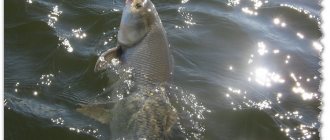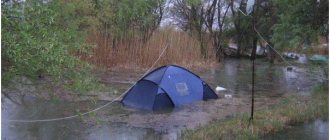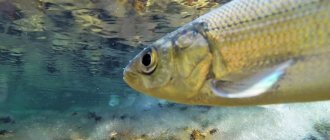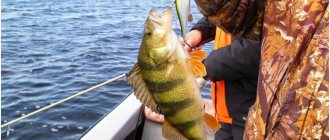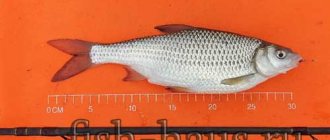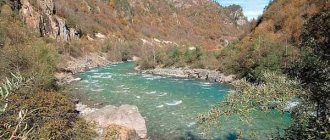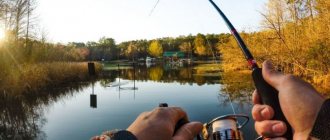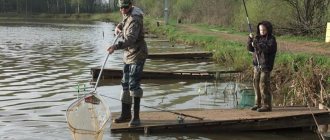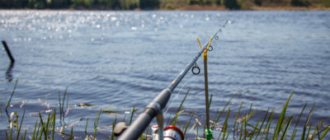A fairy tale, and nothing more. And all around is a jungle of streams, centuries-old willows, the kingdom of reeds, the hubbub of flocks of birds - a real lost world.
Funnels of whirlpools circle above the pits, and here and there the silver robber asp chases small fish with a sharp, biting blow of his tail. Suddenly, a catfish turns out with a gurgle, announcing the beginning of the evening meal with a powerful splash, and this sound makes the fisherman’s heart skip a beat…. The morning is wiser than the evening. Tomorrow it’s a little light – I’d rather go fishing.
Morning. The first rays of the sun break through the wall of reeds, a light mist rises above the water. A popular boat, controlled by the experienced hand of a huntsman, silently glides across the water surface, bringing the fisherman closer to his cherished goal with every second.
Who are we going to catch today? – Catfish, carp, pike perch, pike, perch, asp, ide, rudd, roach, tench, crucian carp, silver bream, sabrefish – such a variety makes your eyes wide open, your head spins, and yet, even in the protected corners of the Volga delta, the fisherman is at chance counting means depriving yourself of the pleasure of a creative, thoughtful hunt for a real trophy, and turning fishing into a lottery - whoever bites will bite. So rely on the huntsman, but don’t make a mistake yourself. And the point is not that the gamekeepers of the places do not know where the fish are found - they know, and how. But, you see, it’s much more pleasant to figure out where the prey is, accurately select the bait, and as a result get the coveted trophy, than to stupidly plow the water up and down, relying only on the great abundance of fish, not knowing exactly who you’ll be dealing with - perch, asp or catfish. Fishing according to the principle “whatever you can do, pour it and drink it” may also have a right to life; in the end, everyone chooses for themselves. But today we will talk about sports trophy fishing, during which it is important for the fisherman not only to catch more and bigger fish, but the main idea becomes a targeted hunt for a certain trophy, and even with a certain gear.
And for such a hunt, you must agree, you need to know some basics of searching for future prey, the subtleties of technology and tactics of catching it. Let's start in order, which is called seniority.
Som
One of the main and highly coveted trophies of anglers in the delta. Sometimes reaching a weight of more than 100 kg, the mustachioed giant can roll a boat along the stretch for hours and, as a result, still overcome the tackle - bend the hook, break the clasp, or simply go into snags and break off the strongest fishing line. Having heard such stories from experienced catfish fishermen, is it possible not to try yourself in catfish fishing? And the way to bite hundred-kilogram giants is not common; there are a great many catfish of the average and slightly below average weight category in the delta channels. Even an unexplored beginner who finds himself in protected areas for the first time can safely count on a catfish bite. And catfish are caught in the delta with varying success during almost the entire period of open water - from early April to mid-November.
In spring and autumn it stays in pits, in the summer heat it often comes out onto the reaches, and sometimes even runs aground. The best time for hunting large catfish is spring, April and autumn, October - November. Although there are exceptions, for example, in July last year, my friend caught nine trophy catfish weighing from 36 to 75 kilograms during a week of fishing, and this in forty-degree heat! But more often in summer the catches are dominated by catfish and catfish weighing up to 10-15 kg. Only occasionally will a boat with a failed companion rush to the base. With his hands shaking with excitement, he runs among his friends from one to another with the same question: “Is there a thick fishing line? I cut it off! 0.6 cut off!” And having finally found a thick cord and a powerful hook, the engine howls and hurries to the river again. But you may not wait for the next bite of the giant in the summer heat.
Catfish are caught in the delta and with spinning rods using jig baits - vibrating tails, rigs, heavy spoons, and vertical spoons, and quok. But more often than not, it’s still the bottom and in the pits. We will talk about this method in more detail today.
The density of the moustached population of the pit can be very, very high. So, one day in April, in a small local hole with a depth of only six and a half meters, in two days I caught more than 30 catfish and catfish weighing from 4 to 26 kg. It was during the filming of a film about fishing in the Volga delta, so the demonstration performances came in handy and, naturally, the overwhelming majority of the catfish, after posing a little in front of the lens, safely returned to their native element. And there are cases when, it would seem, there is no catfish in the most win-win pit, and how to explain this phenomenon of preferring some pits and ignoring others is difficult to say, the fact remains a fact.
Having discovered a hole by the characteristic rotation of the current, along a washed-out bank that drops into the depths, placing the boat at the very entrance to the storm, take a break, take a closer look. In a small and frequent chain, bubbles rise from under the water, as if someone is surviving under water, a sponge 0 - walking, breathing, moving from one depth to another. And suddenly the water parts and an olive spotted body, bent in a semicircle, rolls across the surface. A sharp blow from the tail - and the owner of the pit disappears into the depths. Aha, he showed up, my dear! Well, you can also cook some gear.
With bottom tackle, catfish are most often caught with animal baits - a shell, a bunch of worms (by the way, there is a big shortage in these places) with a frog, with a “cut” - a piece of asp or sabrefish, or with live bait, and you can’t always guess which one today Catfish have an appetite, so it is better to have 2-3 types of bait in your arsenal.
You will need powerful tackle, since it is completely unknown who you will have to deal with - a two-kilogram mustachioed baby, or his five-pound great-grandfather. Choose a stronger rod, a more powerful reel, a thicker fishing line, a heavy sinker, 100-150 grams. A strong and sharp hook, corresponding to the size of the nozzle (for more details on choosing tackle, see the “Arsenal” chapter).
Having planted the bait, try to place the load at the very end of the hole. It is on the edge that catfish most often hunt, wandering around the perimeter of their underwater home. The tip of the rod twitched once, twice, three times, and then the reel squealed with the brake (specially loosened immediately after casting), the line begins to give way - a pull, it’s time to hook!
A catfish sitting on a hook resists strongly, but not actively. There is no agility or agility in him, only solidity and stubbornness, directly proportional to his size. If you feel a powerful heaviness, don’t rush; you shouldn’t play tug-of-war with a large catfish. The fish must be tired. Sometimes you even have to walk around on the motor for an hour, but what the hell, the hook will break or simply come off. So I don’t recommend forcing fishing, even with powerful tackle. It’s another matter if you come across a small nymph - there’s no need to think about it for a long time, take it out, and carefully picking it up by the lower jaw with a hand wearing a special glove, take the fish into the boat and, trying not to injure the fish, remove it from the hook. A couple of photos as a souvenir and the catfish, having gratefully splashed its tail goodbye, sets off to put on weight until we meet again.
Sometimes it is very difficult to convince a fisherman, and especially a beginner, to release the first catfish in his life, even a “baby” one. I really want to show off my loot at the base! But believe me, after just a few days of catfish fishing you will exceed the first, or even the second dozen of trophies obtained. And even if you are a great lover of cutlets made from catfish or smoked catfish, you shouldn’t, in the excitement, move from the pleasure of catfish fishing to commercial catch - take a couple of medium catfish, 10-12 kilograms each (by the way, they are the most delicious), and the rest let them live and make our brother the fisherman happy.
Many catfish lovers, having visited the Volga delta, complain that there are a lot of small catfish, but not enough large ones. There is one secret to catching a really big catfish. And the answer to this question is already half contained in the complaint itself - the true truth is that there are plenty of small catfish in the Volga delta, and therefore there is a chance for a walnut-sized frog attached to the hook of your donkey to end up in the mouth of the long-awaited giant, which swims right there, nearby - almost none. Large catfish must be caught with a large bait! - A frog, half a kilo in size, a weighty sabrefish, an asp, weighing a kilogram, a small bee, 40 centimeters long - these are his baits. You will need appropriate gear - a powerful fishing rod, a baitcasting reel, a thick, durable braided fishing line, a 150-200 gram sinker, a durable carabiner, a reliable leash about a meter long, a strong forged hook.
The principle of constructing gear for catching catfish is simple and primitive - a sliding sinker is put on the main fishing line, its downward movement is limited by a carbine to which a leash with a hook is attached.
When fishing in snags, they often use a rig with a sinker on a separate leash made of monofilament, and the thickness of this leash should be small, but sufficient for casting (0.25 mm is quite enough). During the fishing process, if the catfish goes into snags, the sinker comes off and you are fighting the fish on the free main line. In this case, it is more difficult for the catfish to confuse and catch the tackle.
Fishing for a large catfish is a long and labor-intensive process, and therefore a special belt with a pencil case into which the butt of the rod is inserted will not hurt. By redistributing the load on the back and hips, such a belt will allow you to cope with almost any fish (a catfish belt can be ordered at any halfway decent fishing store).
When bringing a large fish to the boat, if there is at least some chance of getting it over the side, and not having a swim yourself, grab the catfish by the lower jaw with a hand wearing a mitten. If you don’t know this technique, or suddenly you are overcome by superstitious horror, you will have to resort to a hook (although, to be honest, throughout Europe, the use of a hook is considered barbaric; too many fish are maimed this way). Having carefully picked up the catfish under the lower jaw (usually a huntsman does this), and having overcome fear, additionally taking it by the jaw with your hand, smoothly and consistently transfer the catfish into the boat and hurry to weigh the prey and take photographs as a souvenir. If the catfish is caught very large, it is unlikely that it will be possible to pull it into the boat, even with two people. If you still decide to present your catch to an enthusiastic public, try to drag a strong rope into the same hole from the hook under the lower jaw, and in no case under the gill. Pulling the catfish's head to the side of the boat, tow the prey to the base at low speed. Catfish is a tenacious fish, and even during 50-degree heat, it remains viable for several hours, but you shouldn’t abuse this, so if you haven’t decided where to put 100 kg of catfish, try to injure the fish as little as possible both when fishing and when on the way to the base, during the weigh-in during the ovation arranged in your honor. Everything must be done carefully and quickly. It is best to weigh a catfish not by hanging it by the jaw “on the rack”, that is, using the hook of a scale, but by wrapping it in a piece of tarpaulin - then you certainly won’t hurt the fish. Let’s say you were lucky and managed to catch a huge catfish, but there is nothing to weigh such a giant, or the scales are simply going off scale, and you, like any normal fisherman, are curious to know whether the world record has been broken or not. You can use the old method - measure the length of the catfish, if it is two meters, its weight is about 70 kg, every next 10 cm gives 10 kg of weight with an accuracy of plus or minus 2 kilos. Of course, this method of measuring weight cannot be very accurate, but, you see, it’s better than nothing at all. At the end of the solemn rejoicing in honor of the record-breaking trophy, I advise you to release the catfish. Think about it, if he lived to reach that weight, then he has a lot of years to live too. Maybe he will be older than you. So let him live in freedom, and let someone else wait with bated breath for his bite and, with trembling knees and numb hands, feel the moment of victory when the water near the boat parts and a huge mustachioed head with small attentive eyes appears. A real fisherman must respect his prey, especially if it gave him priceless moments of selfless fishing passion and excitement.
Carp
A bronze, armor-clad hero is the dream of every carp fishing enthusiast. There are a lot of carp in the Volga delta, you can come across a wide variety of trophies, from one and a half kilograms to 10-15, and this is already a serious catch. It is caught in season from spring, from about the middle - from the end of April, depending on air and water temperatures, until the autumn cooling in late October - early November. In the spring, the carp prefers animal baits - a crawling worm, a shell, a crayfish neck; in the summer it switches to a vegetarian diet - porridge, cakes, boilies, and by the fall it returns to the meat table again, not disdaining, sometimes even fry (it is no coincidence that in the spring and autumn more than once I came across carp on a spinner, a twister, and a rig with fry).
In spring and autumn, the easiest way to look for carp is in pits, on the reverse flow, near snags, at the roots of washed-out trees, and near a steep bank edge. In summer you can often find a whole flock of carp in a shallow bay near the reeds, in the vast pasture of Caspian peals in the grass thickets. It’s not easy to catch a carp here - the cautious fish won’t let you get close, the only chance is to quietly approach the boat no closer than 15-20 meters to a pre-fed spot and throw a tasty bait right under the nose of the carp, using float tackle for long casting. This elegant method of catching carp in the delta is rare; it is mainly used by true connoisseurs of float fishing. Not everyone will be able to cope with a powerful fish on thin gear, especially in thickets of grass; most fishermen hunt carp with bottom gear, fishing for hot spots on the reverse flow, holes, and at the confluence of channels. In spring and autumn, the traditional bait is a bunch of crawling worms or a shell. You need to choose a large and tough worm - there will be a small, puny dung beetle that will eat fishy bits on the way to the bottom. It’s best to stock up on crawlies in advance, and such that little things won’t fit into your mouth.
Having chosen a place, you can immediately start fishing, but it’s still better to attach a couple or three places in advance. For bait and bait in these unspoiled places, any food waste from the dining room is suitable - buckwheat, potatoes and other food left over from lunch, and if you add cake, soaked corn, and a handful of fried hemp seeds to the bait, the carp will literally lick its lips with pleasure. It is better to weigh down the bait in a strong current with clay and, forming large lumps, feed generously to the chosen place. In just a couple of hours you can start fishing.
It’s not easy to get a pearl barley shell in the spring and late autumn - you probably won’t want to swim in icy water, but if you find a small shallow lake - ilmen and don’t be too lazy to climb in the swamps and collect a bucket - other shells (you can, of course, encourage the huntsman to do this ), the carp will thank you for your favorite delicacy with powerful, decisive bites.
Bottom tackle for catching carp from a boat is a fairly powerful, but not long (2.1 - 2.4 m) rod with a test weight of up to 80 - 100 grams. Reel - of your choice, inertia-free, multi or simply Nevskaya, fishing line - main, if mono - 0.4 - 0.6, if braided - 0.25 - 0.3. The leash is always made only of soft braid 0.2 - 0.25 mm. Sinkers - 80-100 grams, sharp carp hook, proportional to the bait. The equipment is similar to that of a catfish, described above, but thinner; after all, a carp is not a catfish, and you shouldn’t frighten it with a rope of incredible thickness and huge hooks.
When fishing with a shell, every fisherman was faced with the problem of instantly eating the bait with voracious little things - the solution that one iconic Polish fisherman suggested to me turned out to be simple, like everything ingenious: to outwit the annoying little things you need a piece of a lady's nylon stocking the size of your palm. In the center of it, place the meat of a couple of shells, folding the corners and pulling the nylon, tie the resulting bag with thread, you get a kind of “dumpling” wrapped in a stocking. We cut off the excess stocking and tie the dumpling to the hook with the same thread. The result is a “hairy” rig, very similar to the one used for fishing with boilies.
The size of the hook is selected in accordance with the size of the resulting boilie (approximately 2/3 of its nominal diameter. The result is amazing - the little thing pulls, butts, bites the dumpling, but cannot eat it. And the carp swallows it whole, and along with the hook. Thanks to this trick , more than once I managed to get excellent carp without wasting tons of shells for the amusement of the ubiquitous voracious silver bream.As the water warms, vegetarian dishes appear more and more often on the carp menu, and the bait also changes - porridge, cake, corn, boilies are included.
I repeat once again that for successful fishing of carp, preliminary feeding is very desirable, especially when fishing with boilies, and in this case you need to feed not only corn, cakes and cereals, but also the same boilies, so that the carp gets used to the new food.
The carp actively catches both in May, before the flood, and in June, in high water, and in the sizzling heat of July it remains, perhaps, one of the few fish that doesn’t care about anything, and its bite is very active at this time. Wild carp will give 100 points to any carp in terms of strength and passion for resistance. So the memories of the unforgettable moments experienced in the protected wilds of the Volga delta, when the ringing fishing line cut the water with a whistle, and the fishing rod, bent over, bowed to the tenacity of the Volga hero, will be enough for you for the whole long winter.
Fishing in the Volga Delta
Now the weather is good in Astrakhan, bright sun and warmth during the day, comfortable weather for fishing!
Very good fishing for predators: pike, carp, roach, bream, crucian carp, catfish!
Book your trophy fishing trip: accommodation from 1000 rubles/person/day!
The mouth of the Volga River is a complex interweaving of channels and branches. The main channel along which ships sail is called a bank, and the multiple channels clinging to it from both edges are called eriks. At some distance from the navigable channel, the eriks smoothly turn into routs - relatively shallow areas. Fishing in the Volga delta is promising in all areas of the river mouth. But due to the fundamental differences in coastal topography and the characteristics of the bottom of reservoirs, fishing methods vary.
Popular fishing in these places is for the predatory carp fish - asp, which is found here more often than in other parts of the Volga, and is less picky about the choice of bait. The delta is also home to a large number of predatory fish of other species, although one cannot count on record trophies here, which is why there are fewer competing fishermen in these places.
In the bank area, the depth ranges from 8 to 15 meters. You can fish here both from a boat and from the shore. Frequent trophies in these places are asp on a spoon and catfish on a donka, or quok with bait from a piece of fish.
The depth of the eriks is less than the depth of the banks, but the flow speed is greater. Fishermen come here for carp, which live in deep snags. There are frequent cases of catching carp weighing up to 7 kilograms in eriks.
The largest variety of fish species is found in the riparian zones. Many herbivorous fish and predators are caught here. Gambling fans of active fishing will enjoy hunting for pike, grabbing a spoon, spinner or jig near the surface.
Asp
The silvery robber, the owner of river streams, is almost the main trophy for spinning fishermen in the Volga delta. If your dream of catching an asp on the Oka River near Moscow never came true, no matter how hard you tried to get it right under the nose of the most asp spoon, then here in the Volga delta there is every chance not only to catch your first asp, but also to enjoy I got my fill of asp fishing, having caught a hundred to one and a half hundred silver fish weighing from 2 to 3-5 kg in a couple of days. And if you approach fishing creatively, you can hunt for a really big trophy.
There are a lot of asps in the Volga delta. And considering that this fish is schooling, finding a place to start fishing is not difficult. Most often, the asp stays above holes in the upper layers of water, where swirling whirlpools carry food—small fish—in a powerful stream. You will also find him on the breaker jets, behind the shore cape; he really likes to go out onto the sandbanks at the edge of the jets. The owner of the riffle does not always reveal himself with a characteristic noisy fight. Quite often I had the opportunity to catch an asp blindly - in half the water, or even the bottom. This remark especially applies to the periods of early spring (early April) and late spring (mid-late November) fishing. Often at this time, the asp chose very unusual sites - on a calm current, near flooded snags - cramps and hunted like a pike from an ambush. By fishing such completely unasp places with a large oscillating spoon or silver spinner (most often Mepps Aglia Long No. 4), passing the bait leisurely between the snags, you can get an excellent trophy.
My record is 9.5 kg. caught in the Gandurinsky hunting area, and my friend was able to catch a monster of 13.7 kg. (near the village of Karalat). As the water warms, the asp becomes more active and hunts excitedly in flocks. From the new half of summer until the very end of October, and even until November, the place of such a feast can be seen from a great distance, splashes, splashing, scattering fry, the hubbub of seagulls above the water.
Trying not to make too much noise, approach the battle site by boat. You can fish it in different ways; sometimes excellent results are obtained by fishing by drifting across the stream, using an oscillating spoon (the famous Kastmaster, or any other silver-yellow narrow-bodied spoon). If bites are rare and empty pokes occur, change the location of the boat by going upstream, and comb the selected area with a spinner or a floating wobbler, moving the bait against the current. This technique will seduce even a capricious asp; when going out along the stream to attack, the asp hits the bait with such greed that sometimes the reel handle almost flies out of his hands.
Catching a schooling asp is an exciting process, when bite follows bite, you lose the sense of reality in what is happening. Stop! Look around! There are a dozen and a half fish in the boat, each weighing 2-3 kg. Ves, isn’t it time to stop and switch to catch-and-release fishing? Otherwise, you’ll have to decide what to do with a hundredweight of asp. It is unlikely that you will be able to eat such a quantity of fish; you can, of course, take 5-6 carcasses with you in the form of balyk, but what should you do with the rest of the fish? Throw it away? Barbarism - agree. It’s better to let her go safe and sound, because after all, we’re not going for kilograms – we’re going for pleasure, right?!
Catching an asp in the Volga delta is not difficult, especially when there is a feeding frenzy, but not everyone manages to catch a record specimen and not always, well, 3, well, 5 kg, but you want a larger delta after all - protected areas!
The chances of catching a trophy asp by chance are not great; you will have to hunt for it separately and purposefully. First of all, keep in mind that in any large active school of asp, against the background of average-sized fish, there may be very large relatives, it is useful to switch from time to time when fishing to a obviously large bait, for example, a wide-bodied spinner of the “Storling” type, or a spinner No. 4- 6 (I most often use Aglia Long or Blue Fox), this trick allows you to “calibrate” the catch, and makes you finally peck at the largest asp in the flock.
Often, a large, seasoned asp hunts alone, and if you notice a powerful blow or a combat turn from afar, somewhere on a stream under a wall of reeds, sneak up and fish this place carefully and slowly. And even if just 100 meters away the cauldron of asp fighting is noisily boiling, from which just yesterday you were dragging peaceful asps over and over again, don’t rush, you can take the coveted trophy right here, in a completely inconspicuous place.
Asp can be caught in the delta throughout the open water season, only at the height of the summer heat in July; the bite is very sluggish. And yet, from the rest of the period, when it comes to catching a trophy asp, I would single out April and October, it is during these months that there is every chance of catching the largest and strongest Volga asp.
Returning once again to baits, I want to emphasize that you can fish with a variety of spoons, a wobbler, a Devon, and a fly, but the key to success is not in the bait, but in the ability to determine where a large fish is holding, and correctly present it with the chosen one bait All these skills come quickly with experience and can only be learned through practice, so fish often.
Zander
To be honest, there are not a lot of fish in the Volga delta; for this fish it is better to go a little higher on the Volga to Akhtuba, to the Vogograd and Astrakhan regions, choosing places 100 kilometers above the city of Astrakhan.
The thing is that there are no characteristic pike perch places in the delta, with the possible exception of the area of the village of Vyshka, which is at the exit of the Main Bank to the Caspian Sea, where schools of fanged fish stay on the clay bottom. In other places, only occasionally there are non-silted pits and sandy and clay rifts where you can find pike perch. So, you can’t count on record catches of pike perch and trophy specimens when going to the Volga delta.
Only during the spring and autumn migration can you come across a very significant school of fanged predators and catch a dozen or more fish, but their weight usually fluctuates around 1 kg.
Pike perch are caught in the delta most often in two ways, by spinning with jig baits (vibrating tails, twisters with a weight-head weighing from 16 to 40 g), or by vertical lures, all with the same twister, and a heavy faceted spoon. The jig fishing technique is simple and generally accessible.
– step-by-step retrieval at the bottom, with rare pauses, and a good hook after the characteristic “pike-perch knock”. They catch it by swimming with a vertical lure, launching a boat downstream. Having tapped a hole or edge and got a couple or three zanders, they again enter from above and repeat the passage.
There is nothing particularly tricky about catching Volga pike perch, and therefore you should not pay special attention to this issue. Finally, I’ll share just a couple of observations from my own practice. Often the pike perch stands half a meter from the edge of the washed-out shore; it can be caught by simply lowering the bait vertically down and shaking it a couple or three times at the bottom. I don’t know what makes the pike perch literally press into the bank, but once I noticed this feature, I more than once caught pike perch from under the bank, while there was no bite at all on the channel edge.
During a sluggish bite, the best bait for pike perch is a rig, or a jig with a fry; not a single artificial bait can compete with the fry when it comes to catching the capricious pike perch, especially on hot summer days. Don’t be lazy to catch live bait and you’ll definitely end up with a catch.
Other holiday options
Some tourists prefer to relax in the Volga delta like a savage. In this case, you need to be prepared for some difficulties. For fishing to be truly exciting, you need to know the places where the bite will be stable and active. Fishing in the Volga delta is carried out with special permission. Almost all specialized recreation centers have it. However, those who decide to relax on their own will need to first find out whether it is possible to fish in the place of the river where it was decided to set up a mini-campsite.
It is much easier to rent a room in one of the hotels or stay at a special campsite. In this case, many difficulties can be avoided.
Those who decide to come to these parts with their family can, in addition to fishing, relax on the beach. It will also be interesting to go hiking in the forest, pick berries or mushrooms. Most hotels have animators working with children. In the evening you can bake fish on the fire, enjoy relaxation and tranquility.
Pike
Even if this fish is considered a weed in the Volga delta, catching pike is always interesting and exciting, especially large ones. The Volga channels merging with the Caspian form the famous Caspian peals - boundless shallow expanses overgrown with islands of reeds, an intricacy of pondweed, and water lily leaves - a real pike kingdom. The toothy predator is the sovereign mistress in this kingdom, and here in ideal natural ambushes there is great abundance.
I have never seen such a quantity of pike as in the Caspian Sea, sometimes it seems that there is more fish than water. Judge for yourself, without leaving one point, 72 pieces in 2 hours. Fish size from 1 kg. up to 6.5 kg! The spinner barely has time to splash down - splash - grab - there!
Such crazy pike fishing is far from uncommon in the Caspian Sea. Pike fishing begins in early spring at the end of March and beginning of April, followed by an approximately 2-week break for spawning and again the pike zhor gains strength. In May and June, high water makes its own adjustments to pike fishing, the fish go into the hollows, and they are caught in the shallows among bushes and thickets of grass. In July, in the very heat, pike can be seduced only at dawn, and only with a bait precisely placed under the nose; already in August the bite becomes more active, and by autumn it again turns into a real glutton, which continues right up to the freeze-up.
Catching pike on the rips is very exciting, the depth is only a meter and a half, and later even 20-30 centimeters. There are thickets of reeds and algae all around. The bite happens literally before our eyes. And every spinning angler here knows how the pike resists; jerks and pulls, candles and dances on the tail - wonderful fishing! There is only one hindrance - the grass is always clinging to the hook. The solution is simple: non-tagging baits created specifically for fishing in snags and thickets will solve all problems. (photo No. 6)
Floating wobblers and poppers are excellent bait for catching pike at shallow depths. As if throwing the bait into a window of clear water, you will see a pike attack as if in a movie.
When there is an abundance of fish on the very first day, having taken your breath away in captivity, you begin to experiment with baits and hunt only for large prey. The first rule when catching large pike is big mouth, big bait. Spinner No. 6, or even larger, a large spinner (but thin so that it doesn’t immediately fall to the bottom), a fleshy wobbler, a popper, or a large vibrotail on a light tackle, all these baits are very popular with the large Volga pike. There is no need to be shy with the size. 15-20 cm bait is quite tough for a pike weighing 2-2.5 kg. , and smaller pikes often attack it, but with a large bait there is every chance of catching a real crocodile.
The gear for pike fishing is nothing extraordinary. You will need a reliable and durable spinning rod 2.4-2.7 meters long with a cast weight of 10 to 40 (50) g. An inertia-free reel should be preferred, since you will be fishing at shallow depths with high casting accuracy, with constant experiments with baits.
Braided fishing line 0.18-0.22 is quite sufficient to fight already with 10-15 kg. pike, a soft and durable braided metal leash is an irreplaceable thing for pike fishing. We have already talked about bait, but as for fishing tactics, even with an abundance of fish, you need to look for a worthy trophy and search activity is the key to success.
Winter fishing in Astrakhan
Winter fishing in Astrakhan is rich in catches, almost the same as autumn. Winter is a time when even during a decline in the bite, the catch cannot be called meager. You can catch pike, pike perch, perch, roach, saberfish, tarashka, and bream.
We would like to warn those wishing to fish from the ice: towards the end of autumn the Volga delta freezes, but the ice is heterogeneous (of different thicknesses), so take precautions and safety measures, check the strength of the ice before standing on it.
Winter fishing in Astrakhan is adventure and excitement! Sometimes the weather is unfavorable, with pressure changes, lack of sub-zero temperatures and even rain. But avid fishermen are not afraid of the vagaries of the weather; they can always move to a more favorable place.
We invite all winter fishing lovers to our base “Itil”, where you can successfully go fishing and deliciously cook your catch. Arrange a New Year's corporate party or a family winter vacation with us.
Weather conditions for fishing in winter in the Kamyzyaksky district of the Astrakhan region
| Average air temperature during the day | Average air temperature in the evening | Number of sunny days | Number of rainy days |
| -1 °C | -4 °C | 31 | 16 |
Perch
To drag a large, well-fed perch with a light spinning rod, what could be better?! In the Volga Delta you have every chance to get real pleasure from perch fishing. Striped fighters stay in flocks above the flooded shallows, in bays overgrown with reeds, and graze on the ruts. The exciting striped safari continues almost the entire season. On a spinner, on a light jig, on a wobbler, on a popper, on a vertical spoon, on a jig with a fry - everyone fishes in their own way. The main thing is to find the perch, but catching it is not a problem. One and a half, two hours of fishing and there are fifty excellent humpback salmon in the boat, this is not for you to catch sailors in the Moscow region.
And yet, in order to catch a large perch against the backdrop of an abundance of average, although quite decent, 300-400g. extraction will have to work hard.
Firstly, you need to look for large perch. Often, perches weighing 300-400 grams gather in one school, and 500-700 grams in another, which is located next door. Don’t be lazy to change places, travel along the routs, and you will definitely find a large perch.
Secondly, I advise you to experiment with baits, it happens that a medium-sized perch takes a spinner, but you put a spinner or wobbler and immediately you come across a large one, or vice versa.
Perch in the Volga delta is rarely found weighing more than 1 kg, but you will agree that it takes 500-800g. humpback whales, and even when the bites follow one after another - it’s so far away.
One day, while hunting for perch on board a small boat, I noticed a strange feature in its behavior. Perches gradually gathered from all over the area right under the bottom of the ship, either looking for shade or simply out of curiosity, to see what this big thing had appeared in their hunting grounds.
Already 10-15 minutes after our boat touched its nose to the shore in one of the channels, the first perches were moving at the bottom of the huge bucket given to us by the captain for collective fishing. The first bites were 20-30 meters from the side, but after half an hour the perch came close, and most of us switched to vertical spoons, pulling out one perch after another right from under the side. Within an hour the 20 liter bucket was full. By evening, smoked perch with Astrakhan beer is guaranteed!!
Perch fishing in the delta is interesting and exciting, and even when there is excellent catch of catfish, asp and other large fish, I always devote at least a day to perch hunting. The fish is really good! And how he resists! An eight hundred gram perch will probably give a head start to a two kilogram pike.
Occasionally, in order to increase the pleasure, I deliberately switch to ultra-light tackle; a rod with a weight of 2 to 8 grams, equipped with a light reel and thin fishing line, bends to its death when the humpback perch is raging on the lure. Beauty, and that's all!
Lotus Valley
Fishing in the Volga Delta is not the only entertainment that attracts tourists from all over our country. One of the most beautiful places is the Lotus Valley. Optimal conditions have been created here for these flowers. The height of some of them sometimes reaches 2 meters.
Sailing on a boat on the clear, calm water surface between the lovely flowers, you can feel like a part of this beautiful nature. In the first half of the day, lotuses open their petals. At this time, a walk along the river becomes the most romantic and impressive. In the evening the buds close.
Lotus blossoms begin at the end of July. These plants open their buds on the water surface within just 1.5-2 months. In September their flowering stops. Tourists come here from mid-August. At this time the heat begins to subside. Scientists say that even the aroma of lotus helps heal depression, fatigue, and relieves stress.
Rudd
The goldfish has taken a liking to the grassy bays. It frolics in fat herds in the vast expanses of the Caspian peals, right next to the wall of reeds, in quiet backwaters. Catching rudd with a fishing rod is simple, but elegant and exciting. Having baited a place near a thicket of grass with a depth of one and a half meters, put a worm or maggot on the hook, wait for a bite. The float shook and floated to the side. Sweep! And the first fish shimmers with the red gold of its scales and the rubies of its fins. Before the float had time to rise, there was a bite again. And off we go!
You look and the tench will approach and the crucian carp, or even the carp will tumble in. You won't be bored.
Rudd can be caught not only with a fishing rod, but also with an ultra-light spinning rod, small (No. 0, No. 00) spinners, micro jigs, and microwobblers. Considering that this fish is schooling, it actively resists and sometimes reaches a weight of up to a kilogram, fishing turns out to be the most sporting one.
So we talked to you about catching the main trophies in the Volga delta. Fishing in these parts is wonderful in its diversity and unpredictability. It will not be possible to talk about all its nuances in one article. And even if today we didn’t talk about fishing for tench, bream, crucian carp, roach, sabrefish, and many other inhabitants of the protected spaces of the Caspian Sea - it’s impossible to comprehend the immensity. Let at least something remain a mystery, a surprise, a secret, because fishing is a real mystery, a mystery of understanding nature and oneself.
Natural beauty
The Volga Delta is considered a protected area. Its flora and fauna are diverse and abundant. The Astrakhan Nature Reserve was one of the first in Russia. It was created at the beginning of the last century. Only almost a hundred years later the second Bogdinsko-Baskunchaksky Nature Reserve appeared.
In these parts there are 4 reserves, which are also protected by the state. There are natural monuments and hunting grounds. Many tourists go to Lake Tinaki. Mud treatment is carried out here. A famous resort in our country was built near the lake.
